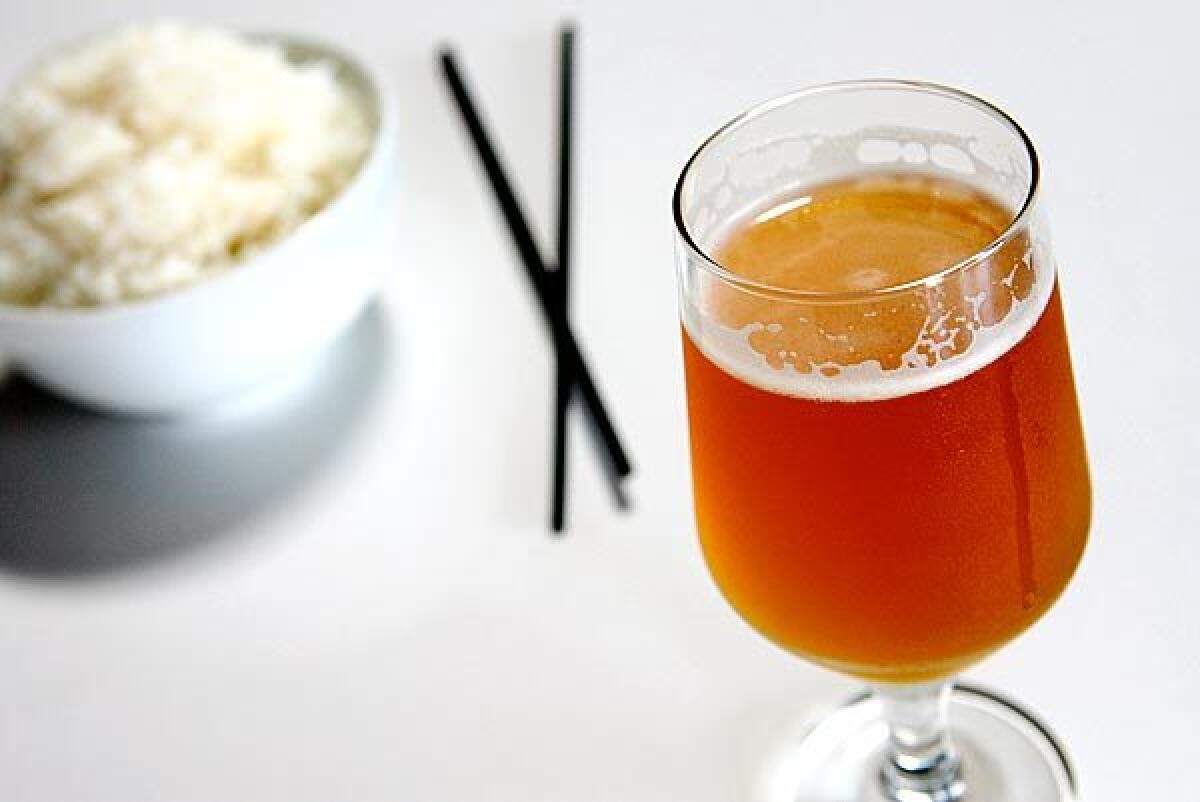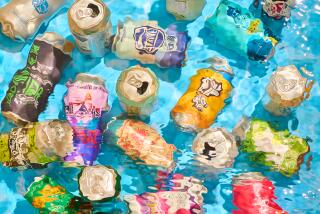Craft brewers rethink rice in beer

- Share via
Ask chefs to dish on their favorite variety of rice and you’ll likely hear words such as fragrant, floral, nutty. But when craft brewers talk about the grain, it’s not quite as reverent.
“Rice is considered by many brewers what the nasty industrial brewers use to water down their beer,” says Maureen Ogle, author of “Ambitious Brew,” a book exploring the history of brewing in the U.S. “Craft brewers treat rice almost as if it’s rat poison.”
But recently, a handful of craft brewers in California, Colorado and Washington are challenging that blanket disdain for the grain by introducing complex, full-flavored rice beers. They say rice can lend subtle tropical notes and a bright finish to their lagers and ales.
“Yes, rice gives beer a light body,” says Brian Dunn, owner and brewer at Great Divide Brewing Co. in Denver. In 2007, the brewery released Samurai, an unfiltered rice and barley ale, to retail outlets. “But it’s also crisp and refreshing, and has a little fruity character that really comes through.”
Despite his enthusiasm, brewers like Dunn are hardly the norm.
“I don’t put rice in my beer,” begins a proclamation against low-quality ingredients in “I Am a Craft Brewer,” a promotional craft brewing video co-produced by Greg Koch, co-founder and chief executive of Escondido-based Stone Brewing Co., the largest American-owned brewery in the Southwest and a craft beer distributor. The video was included in Koch’s keynote speech on brewing ethics to more than 1,500 craft brewing industry leaders at April’s annual Craft Brewers Conference in Boston.
A rice rebellion
Rice hasn’t always had such a sullied reputation among craft brewers.
According to Ogle, the anti-rice sentiment is traceable to the early craft brewing revival in the 1980s. “It was all about, ‘We’re only using four ingredients, we’re not like those industrial brewers making watered-down, cheap beer by using adjuncts like rice.’
“The mythology is that these giant beer makers began adding rice and corn to their beer after World War II to water it down, but that’s simply not true,” she adds.
The American brewing industry was built in the late 19th century by first-generation German American immigrants such as Adolphus Busch, Adolph Coors and Frederick Miller. Although these men, craft brewers themselves, initially re-created the full-bodied beers of their homeland, many Americans had not developed a taste for the malt-heavy style.
“They needed a domestic ingredient that would make the beers more effervescent, bubbly and lighter,” Ogle says. “Rice and corn did that -- it was a desired flavor, not inexpensive filler.”
It is that delicate flavor that has recently captured the attention of the next generation of experimental craft brewers such as Joe Valvo, 33-year-old co-owner and brewer at Trade Route Brewing Co. in Seattle.
“There’s a lot of misconception with rice,” says Valvo, who has offered a rice lager called Dragon King since the brewery opened two years ago. “It lightens the body and cuts some of the malty-ness in a lager.”
Although Valvo has focused on more traditional Japanese-style rice lagers, the majority of the neo-rice brewers have been experimenting with ales. Traditionally most beers that include rice, including American brews such as Budweiser and the Japanese brands Asahi and Kirin, have been lighter lagers.
One of the earliest rice and barley ales to hit the Los Angeles market, Red Sun, was developed eight years ago by the Great Beer Co. in Gilroy, Calif., for the Sushi Roku and Katana restaurant chains.
“When we started looking around for a rice beer to pair with our food, the only options were lagers from the big Japanese brewers that aren’t very flavorful,” recalls Lee Maen, co-owner of the L.A.-based restaurants. “We wanted a more flavorful ale, but lots of those California microbrews are just too rich to pair with sushi.”
Food was also the catalyst for the Bruery’s owner-brewer Patrick Rue. Trade Winds Tripel, a full-bodied, unfiltered Belgian-style golden ale, is made from rice and barley. “My wife and I were having tom kha gai, coconut Thai basil soup, so I decided to experiment with Thai basil and rice to make a full-bodied but lighter ale,” says the Placentia brewer.
He included rice in the formula, he says, because it “lends a really great subtle coconut flavor when left unfiltered.”
Angling for respect
Rue is convinced the trend will catch on. “There are a lot of craft brewers these days who think we shouldn’t limit ourselves to barley.” But the challenge of gaining recognition for beers that can be produced from rice goes beyond the “I Am a Craft Brewer” video.
“At places like the Great American Beer Festival, craft brewers are applauded for adding odd ingredients,” but rice is considered “the worst thing ever,” says author Ogle.
The annual festival, held last weekend in Denver, draws nearly 50,000 beer fans to its tastings. Hundreds of craft brewers enter the well-respected professional brewer’s competition.
“American brewers are very creative . . . in taking all kinds of ingredients and creating a whole new idea of what a specialty beer is,” says Charlie Papazian, president of the Brewers Assn., the nonprofit trade organization that operates the festival. “That’s something we encourage.”
But there wasn’t a rice lager category until a few years ago; there’s no category for rice ales.
Rue, who is featured numerous times throughout the “I Am a Craft Brewer” video, attempted his own creative wordplay while reading the script.
“When we got to the part about the rice, I said, ‘I do use rice and corn in my beer,’ ” he recalls. “They clipped it out.”
More to Read
Eat your way across L.A.
Get our weekly Tasting Notes newsletter for reviews, news and more.
You may occasionally receive promotional content from the Los Angeles Times.










